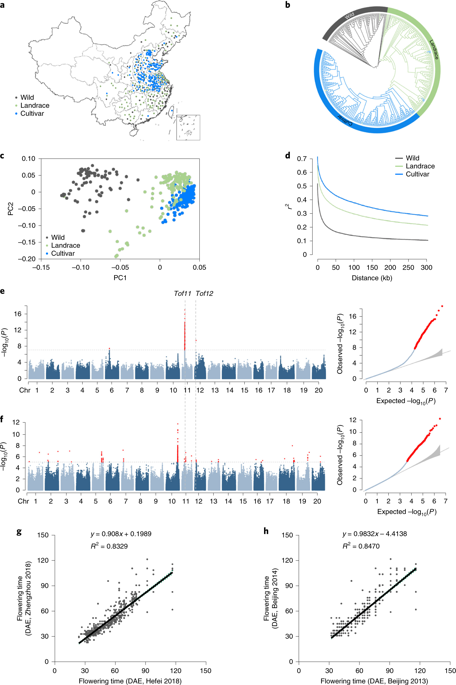Nature Genetics ( IF 30.8 ) Pub Date : 2020-03-30 , DOI: 10.1038/s41588-020-0604-7 Sijia Lu 1, 2 , Lidong Dong 1 , Chao Fang 1 , Shulin Liu 3, 4 , Lingping Kong 1 , Qun Cheng 1 , Liyu Chen 1 , Tong Su 2, 4 , Haiyang Nan 1 , Dan Zhang 5 , Lei Zhang 6 , Zhijuan Wang 7 , Yongqing Yang 8 , Deyue Yu 9 , Xiaolei Liu 10 , Qingyong Yang 11 , Xiaoya Lin 1 , Yang Tang 1 , Xiaohui Zhao 1 , Xinquan Yang 1 , Changen Tian 1 , Qiguang Xie 12 , Xia Li 7 , Xiaohui Yuan 13 , Zhixi Tian 3, 4 , Baohui Liu 1, 2 , James L Weller 14 , Fanjiang Kong 1, 2, 4

|
Adaptive changes in plant phenology are often considered to be a feature of the so-called ‘domestication syndrome’ that distinguishes modern crops from their wild progenitors, but little detailed evidence supports this idea. In soybean, a major legume crop, flowering time variation is well characterized within domesticated germplasm and is critical for modern production, but its importance during domestication is unclear. Here, we identify sequential contributions of two homeologous pseudo-response-regulator genes, Tof12 and Tof11, to ancient flowering time adaptation, and demonstrate that they act via LHY homologs to promote expression of the legume-specific E1 gene and delay flowering under long photoperiods. We show that Tof12-dependent acceleration of maturity accompanied a reduction in dormancy and seed dispersal during soybean domestication, possibly predisposing the incipient crop to latitudinal expansion. Better understanding of this early phase of crop evolution will help to identify functional variation lost during domestication and exploit its potential for future crop improvement.
中文翻译:

大豆驯化过程中控制开花和成熟的同源PRR基因的逐步选择。
植物物候的适应性变化通常被认为是所谓的“驯化综合症”的一个特征,它将现代作物与其野生祖先区分开来,但很少有详细的证据支持这一观点。在大豆这种主要的豆科作物中,开花时间变异在驯化种质中得到了很好的表征,对现代生产至关重要,但其在驯化过程中的重要性尚不清楚。在这里,我们确定了两个同源伪响应调节基因Tof12和Tof11对古代开花时间适应的连续贡献,并证明它们通过LHY同源物促进豆科植物特异性E1基因的表达并在长光周期下延迟开花. 我们表明依赖于Tof12的成熟加速伴随着大豆驯化过程中休眠和种子传播的减少,可能使初期作物易于进行纬度扩张。更好地了解作物进化的早期阶段将有助于识别在驯化过程中丢失的功能变异,并利用其潜力来改进未来的作物。



























 京公网安备 11010802027423号
京公网安备 11010802027423号